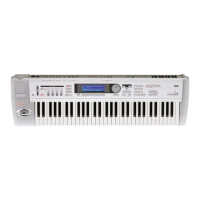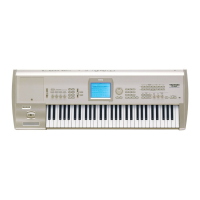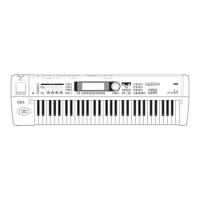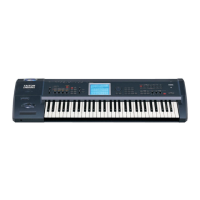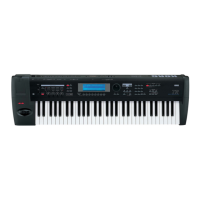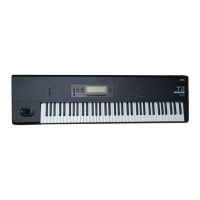2. Program Edit mode
28
2. Program Edit mode
To enter this mode, press the front panel
[PROG] key
and then the
[EDIT] key
.
Here you can make changes to the pitch, tone, volume, and other aspects of the program selected
in Program Play mode. If you wish to save the changes you make, be sure to write the program
into memory (
☞
page 23 in this manual).
For bank M programs, refer to the MOSS-TRI owner’s manual.
How a program is organized
The following diagram shows how a program is organized. The characters in the lower part of
each box (e.g., P2–5) indicate the screen page in which the corresponding parameters are found.
The elements of sound
How the TRINITY’s sound is produced
Sound consists of three main elements; pitch, tone, and volume. On the
TRINITY series
, the oscil-
lator, filter, and amplifier that make up each program correspond to these three elements. Thus, if
you want to adjust the pitch, adjust the settings of the oscillator. To adjust the tone, adjust the filter.
And to adjust the volume, adjust the amplifier setting.
Oscillator: adjusting the pitch
The
TRINITY series
provides two oscillators. For each, you can select the waveform (referred to
as a “
multi-sample
”) that will be the basis for the final sound, and set the pitch. A variety of multi-
samples are provided, including instrumental sounds such as piano, and also waveforms unique
to synthesizers. Each multi-sample is actually a small piece of recorded sound, and thus deter-
mines the basic character of the final sound, whether it will be “guitar-like” or “piano-like,” etc.
Oscillator settings are made in Program Edit mode P1 and P2.
< Editing a program >
The process of modifying the sound by adjusting the parameters that make up a program is
referred to as “editing.” Program editing is done in Program Edit mode.
You can edit programs using the performance editor. Also, in Program Edit mode you have
access to a large number of parameters for detailed editing, providing a wide range of control
over the sound. Since it may be difficult to understand at once how all the parameters work
together to affect the sound, it is a good idea to make adjustments to the parameters of the pre-
set programs in order to learn how each parameter works.
OSC2
OSC1
Prog Basic
OSC Basic
(P1-2)
OSC1/2 EG
(P2-5)
OSC1 LFO
(P2-2)
OSC1 P. Mod
(P2-1)
Filter1 Fc Mod
(P3-2)
Filter1 LFO
(P4-2)
Filter1 A/B
(P3-1)
Filter1 EG
(P4-1)
Amp1 EG
(P5-2)
Insert Fx
(P7)
Amp1
(P5-1)
Master Fx
(P8)
1/L/MONO
2/R
3
4
(P1-1)
Pitch and basic
tone color
Oscillator
Tone color
Filter
Volume
Amplifier
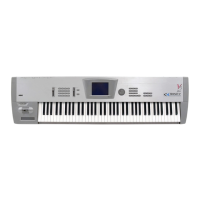
